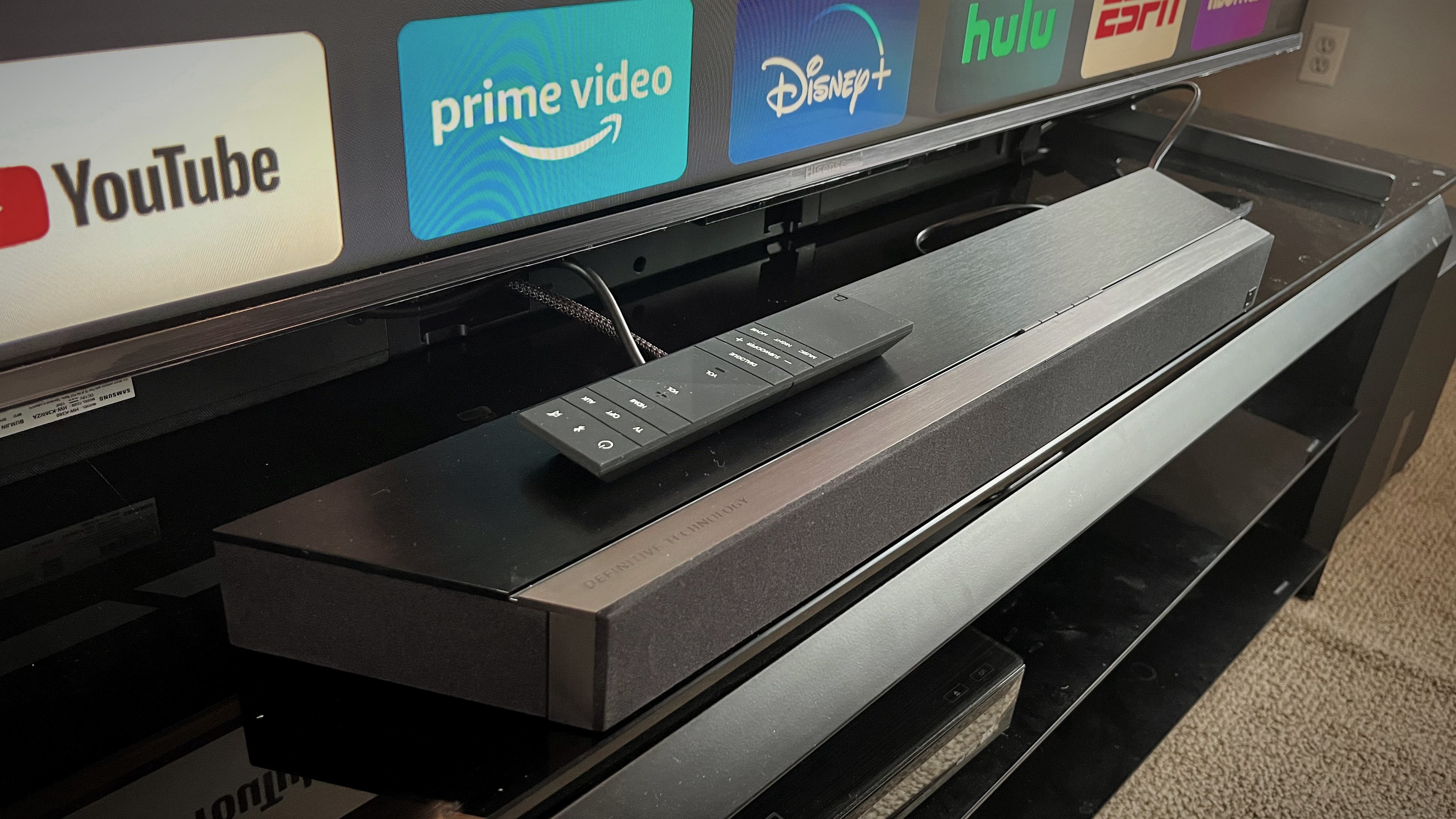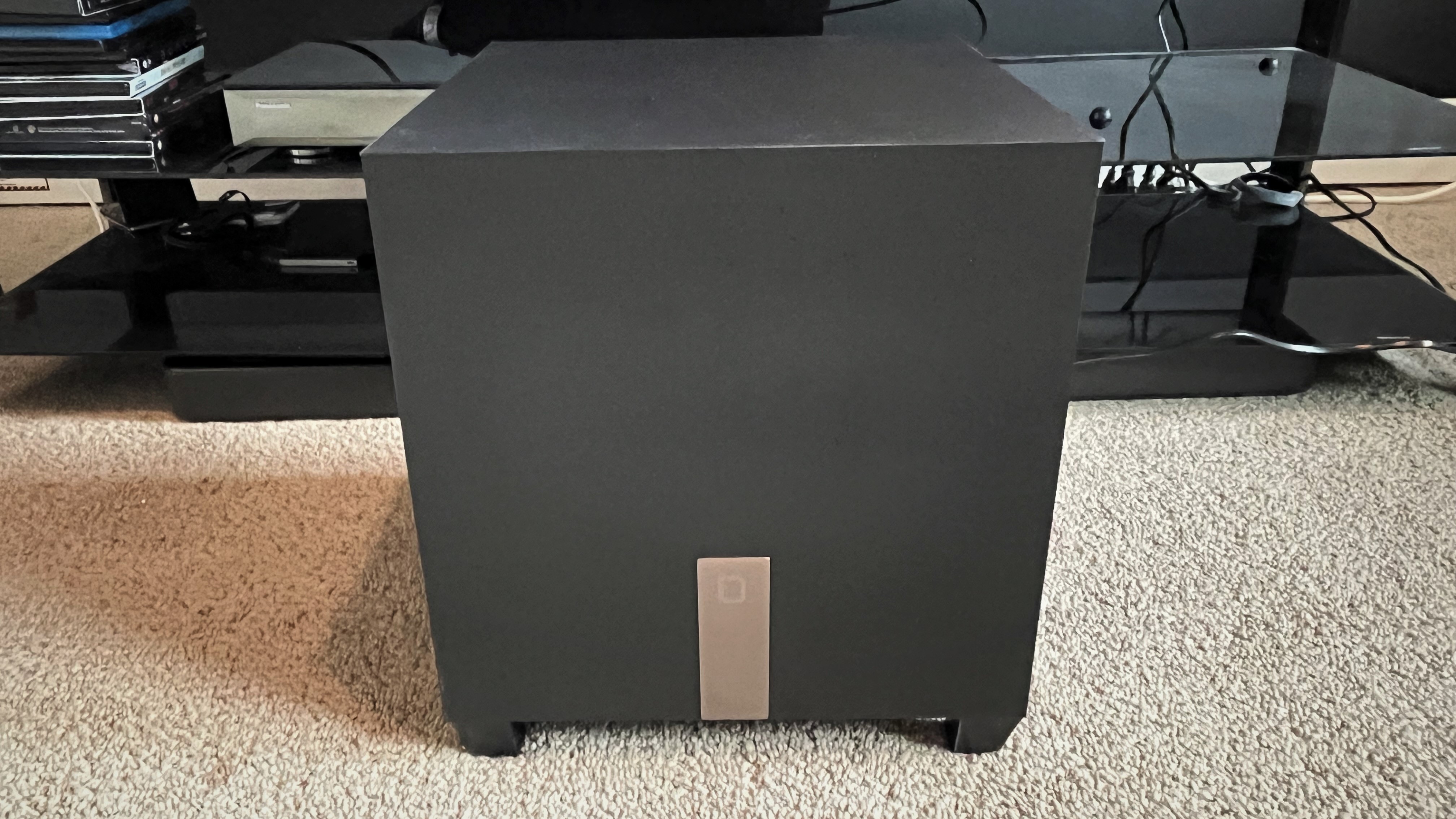I tried a small Dolby Atmos soundbar that beats the Sonos Beam in 4 big ways
Def Tech's Studio 3D Mini is ready to rumble

Speaker maker Definitive Technology’s Studio 3D Mini is the company’s latest Dolby Atmos soundbar offering. It sports the same compact, 26-inch-wide form factor as the Sonos Beam (Gen 2), and has a mostly similar feature set. That includes built-in Wi-Fi for multiroom music streaming, but here using the HEOS wireless platform – the exact one used by big audio brands like Denon and Marantz.
We’ve called the Studio 3D Mini in for testing based on its design and streaming features, both of which make it a compelling alternative to Sonos’ popular mid-range model.
The Beam (Gen 2) currently sits in the number 7 slot on our list of the best soundbars. Can the Def Tech displace it? We’ll soon have the answer after we wrap up our full Studio 3D Mini review. In the meantime, here are 4 ways Def Tech’s ‘bar beats the Sonos out of the box.
1. Comes with a subwoofer
While the Beam (Gen 2) is a fully integrated soundbar with 4 mid-woofers and 3 passive radiators contributing to its bass output, the Studio 3D Mini comes with a separate subwoofer with an 8-inch driver. This gives it an out-of-box performance edge over the Beam (Gen 2), which, in our recent evaluation of the full range of Sonos soundbars paired with the company’s Sub Mini subwoofer, benefitted from the clear, undeniable bass upgrade the new Sonos sub provided.
Of course, the Studio 3D Mini costs $899 / £800 / AU$1,380, while the Sonos is priced much lower at $449 / £449 / AU$599. But when you add the Sub Mini ($429 / £429 / AU$699) to the Beam (Gen 2), the two systems will run you about the same. Factor that into your buying decision, and any price advantage the Sonos might have quickly evaporates.
2. Has an HDMI input and HDMI eARC output
Sonos likes to keep the connection options on its soundbars basic. Even its most advanced Dolby Atmos model, the Arc, features only a single HDMI eARC port, while the entry-level Sonos Ray limits input options to optical digital audio.
Same as with the Arc, connection options on the Beam (Gen 2) are limited to a single HDMI eARC port. The Studio 3D Mini, in contrast, features both an HDMI eARC port for linking to a TV and a 4K/Dolby Vision-compatible HDMI input. The benefit here is that you can connect one of the best 4K Ultra HD Blu-ray players directly to the soundbar instead of having to run it through your TV.
Why is connecting a player directly to a TV a problem? HDMI eARC ports on TVs can pass Dolby Atmos and regular Dolby True HD soundtracks, but, depending on the set, DTS support can be spotty. Which brings us to the next Studio 3D Mini advantage:
3. Dolby Atmos and DTS:X
With the exception of the entry-level Ray, Sonos soundbars support Dolby Atmos, but DTS tops out at basic DTS digital surround, with no support for the higher-resolution DTS-HD Master Audio and DTS:X formats.
The Studio 3D Mini is DTS-HD Master Audio and DTS:X-compatible. That means you’ll get comprehensive home theater audio format support when either playing movie discs or streaming from your TV’s built-in apps (as long as your TV’s HDMI eARC port is similarly featured – see point number 2).
It should be noted here that both the Beam (Gen 2) and the Studio 3D Mini lack upfiring speakers – both use virtual processing to deliver the height component of immersive Dolby Atmos and DTS:X soundtracks via their respective arrays of front- and side-firing speakers. So while all home theater audio formats are supported by the Studio 3D Mini, you won’t necessarily experience the same level of immersion as you would with a more advanced soundbar like the Sonos Arc that has upfiring speakers on its top surface.
4. Comprehensive high-res audio support
One upgrade the Sonos S2 platform brought with it was a bump up to 24-bit high-resolution streaming for supported apps like Amazon Music and Qobuz, letting listeners experience the richness of high-res audio on their soundbars. The HEOS wireless platform used by the Studio 3D Mini also supports 24-bit, but it does Sonos one better by allowing for audio streaming at sample rates up to 192kHz, along with Direct Stream Digital (DSD) ones. (Streaming resolution with Sonos tops out at 24-bit/48kHz.)
At present, you’ll only be able to access those ultra-high-res streams via the HEOS app from either the Amazon Music Unlimited service or your own network-shared storage. And whether or not playing music with that high a sample rate will make a difference on your soundbar is certainly a topic that’s up for debate. But it’s yet another area where, on paper, the Studio 3D Mini shows superior specs.

Other Studio 3D Mini advantages
Beyond what I’ve already listed, another potential advantage to Def Tech’s soundbar system is its use of two separate tweeters for its front-facing speakers compared with the Sonos’ single tweeter – something that could improve general performance with music playback.
There are design advantages as well: the Studio 3D Mini’s steeply angled cabinet has a cooler look than the somewhat bland, lozenge-like Beam (Gen 2), and its included subwoofer oozes more style than the bass cubes typically bundled with soundbars. It also comes with an excellent full-scale remote control – something you won’t find with the Sonos, which uses the S2 app for control, though both soundbars can also be operated by your TV’s remote.
Finally, the Studio 3D Mini supports both AirPlay 2 and Bluetooth wireless streaming, and it’s compatible with Amazon Alexa, Apple Siri and Google Assistant voice commands. We’ll be digging in much deeper with the Def Tech Studio 3D Mini, so check back soon for our full review.
Get daily insight, inspiration and deals in your inbox
Sign up for breaking news, reviews, opinion, top tech deals, and more.

Al Griffin has been writing about and reviewing A/V tech since the days LaserDiscs roamed the earth, and was previously the editor of Sound & Vision magazine.
When not reviewing the latest and greatest gear or watching movies at home, he can usually be found out and about on a bike.